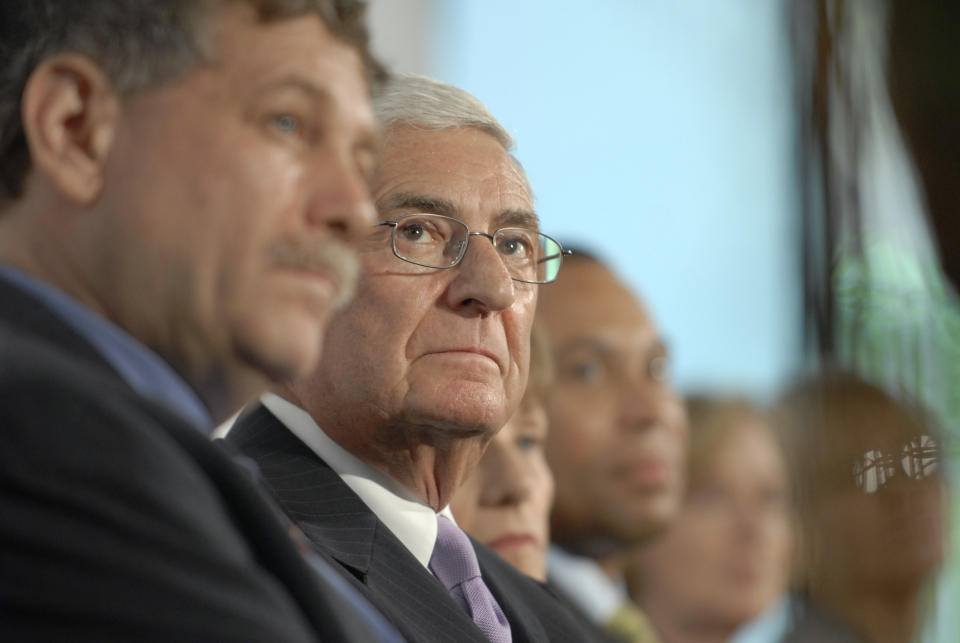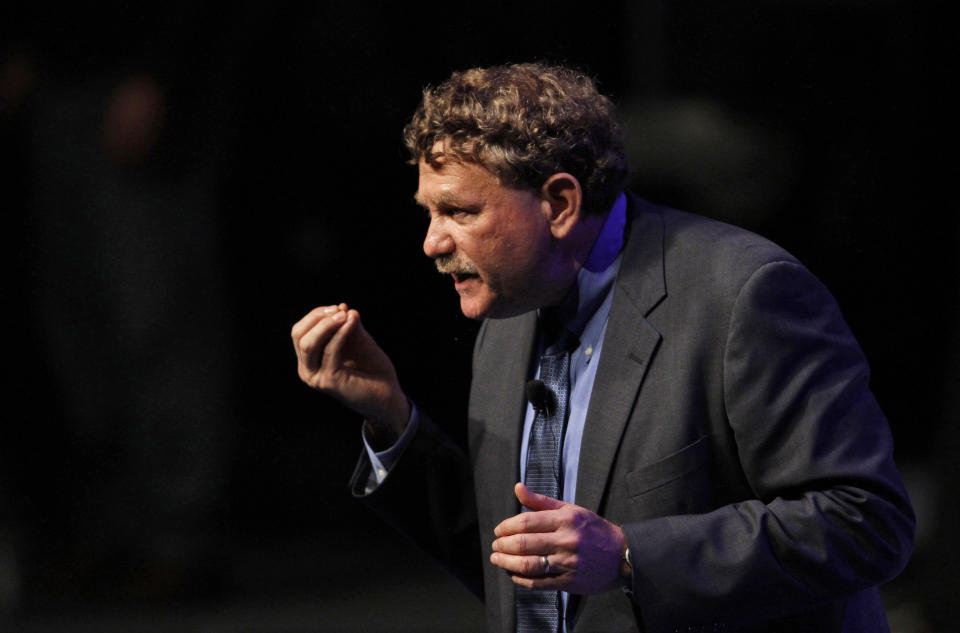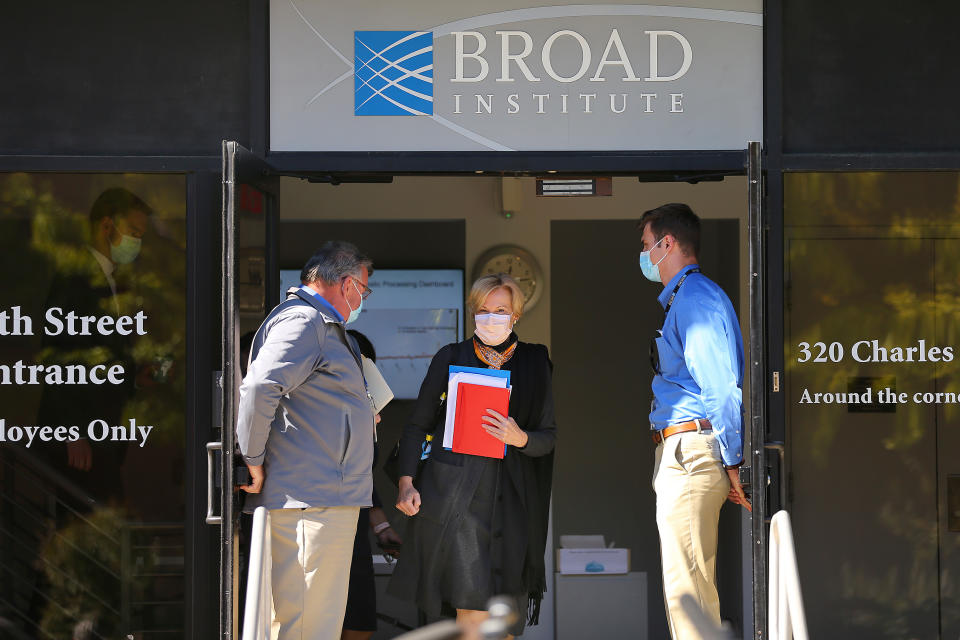The billionaire backstory of COVID-19 testing done right
With all the tragedy and misery that COVID-19 has brought our country (8 million infected and over 217,000 dead), the pandemic is also serving as a kind of test—a test that many are failing. Those who point fingers and stereotype, those who flaunt basic safety measures and especially leaders who flail and abdicate responsibility, come first to mind.
And then there are Americans who’re rising to the occasion; first and foremost medical professionals, but also meatpackers, truck drivers and everyone else who can’t work from home, and of course scientists working round the clock on treatments and vaccines.

Institutions too have stepped up. Restaurants are donating food, whiskey companies are making sanitizer, and Ford has pivoted to producing respirators, masks and other PPE. But maybe the most meaningful changeover is one made by an organization you may not know about, but I bet will soon.
I’m talking about the Broad Institute—or “the Broad” as its habitues call it—and the work done by the remarkable people behind the Institute, its primary charge and its response to COVID-19 and beyond.
Before I get into the rich backstory of the Broad and its world-changing genomics work, (and some Nobel Prize drama too), I should tell you simply put, that the Broad is taking the lead in making our nation’s colleges and universities safe to attend.
“Schools came to the realization they had a choice of relying on their own labs—or Quest Diagnostics for God’s sake—or Broad which has made it possible for schools all over New England to adhere to a standard of frequent screening—a key element to keep them safe,” says A. David Paltiel, a professor of public health policy and management at the Yale School of Medicine.
Working with over 100 schools now, the Broad is doing PCR tests at a clip of 70,000 a day and climbing, using “a novel automation system...that is scalable, modular, and high-throughput.” Turnaround is less than 24 hours. It’s now done 3.3 million and counting tests since March, (see excellent dashboard here), when it reconfigured its high-end genomics labs to facilitate COVID-19 testing.
We asked Chad Orzel, a professor of physics at Union College, where he gets tested for COVID once a week through a partnership with the Broad Institute, on whether he would’ve felt comfortable teaching in person if not for the Broad testing.
“Probably not. I think opening without the testing regime in place would have been very risky,” Orzel replied. “I usually get tested in the morning and hear back by dinner time the next day. It’s been working really well. The testing station is staffed by folks from athletics. I joked that if you want to efficiently move people through routine activities, coaches are ones you want to do that.”
(A counterpoint example of a school not testing through Broad might be SUNY Oneonta where the university president resigned late this week after more than 700 students contracted COVID-19.)
The Broad’s COVID work is about to get much bigger, too as its testing protocols are “being scaled across the country,” says Dr. Thomas Tsai, assistant professor in the Department of Health Policy and Management at Harvard Medical School. “The Assurance Testing Alliance is establishing contracts between employers to take the technology from the Institute and offer that to employers and municipalities and schools all across the country.”
Now that’s stepping up, (and there’s even more to this which I’ll get to a little later.)

So just what is the Broad Institute and who are these remarkable people?
Founded in Boston in 2004, the Broad is a super-science joint venture between MIT and Harvard hatched by billionaire businessman Eli Broad, his wife Edythe (known as Edye) and a singular MIT scientist and polymath, Eric Lander.
First, if you don’t know Eli Broad he truly is an outside-the-box thinker. In his book, (he’s posed on the cover with one of his favorite pieces of art, “Rabbit” by Jeff Koons), titled “The Art of Being Unreasonable,” (with “reason” lettered upside down) Broad tells how he changed the pronunciation of his name to rhyme with “road” himself when he was a boy.
And then there’s his business career. Broad, now 87, built two Fortune 500 companies from the ground up, homebuilder KB Home (which used to be Kaufman & Broad) and then SunAmerica, a retirement savings and insurance company. In 1998, Broad sold SunAmerica to AIG for $17.8 billion and retired from business to focus on philanthropy full time.
It has not been a quiescent retirement. Eli and Edye put billions into the Eli and Edythe Broad Foundation and the Broad Art Foundation which funded education endeavors and the arts. They built the Broad Museum for contemporary art in Los Angeles, and other art museums at UCLA and Eli’s alma mater, Michigan State. They funded gun control work and medical research at schools including USC, UCLA and CalTech. But perhaps what will ultimately be most significant, (which is saying something here), they funded the aforementioned Broad Institute.
By the way, I’m not saying that Eli Broad is all peaches and cream. You don’t get to be a billionaire without sharp elbows and making enemies. Some find his advocacy of charter schools unpalatable and others say he’s taken advantage of tax laws. So be it. I will note though that if the other 500 members of Bloomberg’s Billionaire Index were half as philanthropic as the Broads, the world might have half as many problems.
Eli and Edye met Eric Lander, president and founding director of the Broad, in 2001 on a visit to Boston when the Broads called the scientist and asked to see his lab. Lander—a math PhD from Oxford, a Rhodes scholar, a MacArthur Foundation “genius” award winner at age 30, and a professor of economics at HBS, who was then working on decoding the human genome—greatly impressed the Broads.

“We were fascinated when he told us about an idea to start an interdisciplinary institute to take what he had learned about the genome to bedside application—so it would benefit patients by helping to treat and even prevent disease,” Broad wrote. “Eric had a vision for a new way of conducting science, breaking down the silos that usually keep medical researchers, biologists and engineers from collaborating on common projects.”
But there was just one not-so-small problem. Lander told the Broads he needed $800 million to fund his idea, at which point Eli recalls he “just wished him luck.” But Edye saw it differently. “We weren’t even back in Los Angeles,” Broad continued, “before she started to say, ‘We should give him all our money.’”
While the Broads haven’t quite done that over the past 16 years, (they’re still worth $6.8 billion), they’ve now donated some $700 million to Lander’s lab.
Other subsequent major funding for Broad has come from hedge fund manager Seth Klarman (Baupost Group), $32 million, Mexican telecom billionaire and New York Times investor, Carlos Slim, $74 million, the Stanley family (the fortune behind the Danbury Mint collectibles business), $650 million, and health care investment firm Deerfield Management, $50 million.
First though, Broad and Lander had to get rivals Harvard and MIT to work together, which in itself was no small feat. Broad calls out Larry Summers, former U.S. Treasury Secretary and then president of Harvard, for being instrumental in making things happen by clearing through internal politics at Harvard and helping get MIT on board.
“It was one of the easiest decisions made during my time as president,” Summers told me. “Eric [Lander] was at MIT. It seemed natural to work together and a little crazy that MIT and Harvard were right next to each other and didn’t collaborate. Not to do so seemed to reflect the narrowest and pettiest sentiment. In many ways you can measure it….Harvard’s investment in the Broad has been a spectacular success.”
Those who know Lander and Broad say they have a number of similarities; iconoclastic, visionary, as well as hard-charging. Regarding Broad, Summers says, “I don’t know any other philanthropists who have turned the same rigor, exacting standards and persistence that made them wealthy to their philanthropy in the way Eli Broad, supported by Edye’s shrewd human judgment, has done.”
As for Lander, Summers says: “I’ve known rigorous analytical thinkers and impressive entrepreneurial impresarios. But the only person I know who has both, is Eric.” If you want to get a feel for Eric Lander’s brain and get a good understanding of genomics in one hour, I highly encourage you to watch this video.
The secrets of CRISPR
Today more than 3,000 scientists work at the Broad in a collaborative, holistic environment unique to the world of science. Broad tackles many facets of cutting-edge scientific study, but genomics—perhaps Lander’s greatest passion (if a polymath can have just one)—is at its core. And there at furthest reaches of genomics, in a burgeoning, vital field called “clustered regularly interspaced short palindromic repeats,” better known by its much more accessible name, CRISPR (pronounced crisper), is where there’s been some measure of drama for Lander and the Broad. At stake, protracted high-stakes patent litigation, perhaps billions of dollars of business and the Nobel Prize.

CRISPR technology is seen as incredibly important because it allows scientists to easily edit genes of complex organisms like animals or humans with precision. Researchers harness a process found in the immune systems of bacteria to replace, remove, or rearrange sequences of DNA and change the way genes function. In this way CRISPR is seen as being able to treat diseases such as cancer, blood disorders, blindness, AIDS and more.
Scientists at several institutions, including Feng Zhang at the Broad and Jennifer Doudna at Cal Berkeley along with her associate Emmanuelle Charpentier at Max Planck Institute for Infection Biology in Berlin, have been racing to unlock the secrets of CRISPR technology. In 2016, Lander published an article in the scientific journal Cell about CRISPR, which created a bit of a stir in the academy.
Lander, critics charged, made errors in his piece, didn’t disclose conflicts of interest and downplayed the role of the two women, Doudna and Charpentier, in his story. (The back and forth even sparked a hashtag, #landergate.) Lander pushed back and this article in STAT also noted the part that professional jealousy played in the Lander sniping. Lander’s Cell piece and the ensuing controversy coincided with the commencement of a patent war between Feng and the Broad on the one side and Doudna and Cal on the other, adjudicated by the U.S Patent Office and U.S. federal court. That dispute continues to this day.
“The sandbox at that scientific level can be a nasty one,” a Harvard physician said to me. “I wouldn’t want to play there.”
And then last week, the narrative took another turn in the form of the Nobel Prize. On October 7, the Royal Swedish Academy of Sciences awarded the Nobel Prize in chemistry to Doudna and Charpentier, “for their 2012 discovery that a bacterial immune system called CRISPR can be repurposed to edit DNA, the molecule of heredity,” according to STAT. Even though three can share a Nobel, the committee seemed to pointedly snub Feng. Lander was gracious, however, though some critiqued the compliment.
Huge congratulations to Drs. Charpentier and Doudna on the @NobelPrize for their contributions to the amazing science of CRISPR! It’s exciting to see the endless frontiers of science continue to expand, with big impacts for patients.
— Eric Lander (@eric_lander) October 7, 2020
And Doudna was gracious back: “I’m deeply grateful for the acknowledgement from Eric. It is an honor to receive his words.”
As for Feng, who’s still in his 30s, “he’s got a Nobel in him yet, says a Boston-based biotech executive. Here’s a video btw of Feng Zheng explaining CRISPR.
Nobel drama and patent dispute notwithstanding, Feng, Lander and the Broad are continuing their work. The CRISPR field will ultimately have room for many players. In fact it appears that CRISPR may soon be used for COVID tests. A little noticed release the Broad put out last month announced a “CRISPR-based diagnostic for COVID-19 that can produce results in 30 minutes to an hour, with similar accuracy as the standard PCR diagnostics now used.”
“Our vision is fast, frequent, cheap, easy testing. If you can do that, you can get around issues with central lab testing. You can do it at home, when you’re traveling, when you’re at work,” says Omar Abudayyeh, a McGovern Institute fellow at MIT who along with fellow, fellow (!) Jonathan Gootenberg, conducted research at the Broad Institute while graduate students, (they’ve worked with Feng) and continue to collaborate with the organization on their current research to develop a CRISPR-based coronavirus test.
“Our hope is January for an all-in-one kit,” says Abudayyeh. “One of the areas we’ll start with is schools. Most schools can’t afford expensive testing of people every day. It’s a good cause and the right way to start.”
Taking a step back, I remember in the 1980s when Boston area tech companies like Digital Equipment Corp (DEC), Wang, Apollo and Prime made the so-called Route 128 corridor a legitimate rival of Silicon Valley. The East Coast companies are all toast, but in biotech, Boston goes toe-to-toe with Silicon Valley thanks in no small part to the Broad. Furthermore, with all of big tech’s legal foibles today, Moore’s Law perhaps running its course and all the upside of biotech, you wonder if Boston will regain parity with the Bay Area for tech ascendancy writ large.
But what the Broad is doing today with COVID testing isn’t about commerce really, it’s about stepping up and doing the right thing. Eli Broad set the wheels in motion two decades ago and when the pandemic hit, Eric Lander and his Institute had the wherewithal, the capacity and mindset to act. Down the road the science and processes that come out of this work may pay dividends in all kinds of ways, but for now the cause of getting America back on its feet is reward enough.
Here, the test was itself a test.
This article was featured in a Saturday edition of the Morning Brief on October 17, 2020. Get the Morning Brief sent directly to your inbox every Monday to Friday by 6:30 a.m. ET. Subscribe
Andy Serwer is editor-in-chief of Yahoo Finance. Follow him on Twitter: @serwer.
Read more
What you can learn from Jeff Bezos, Ray Dalio and Reed Hastings
Here's what Bill Gates and Warren Buffett talk about during COVID-19
What America can learn about reopening from the state of Maine
Read the latest financial and business news from Yahoo Finance